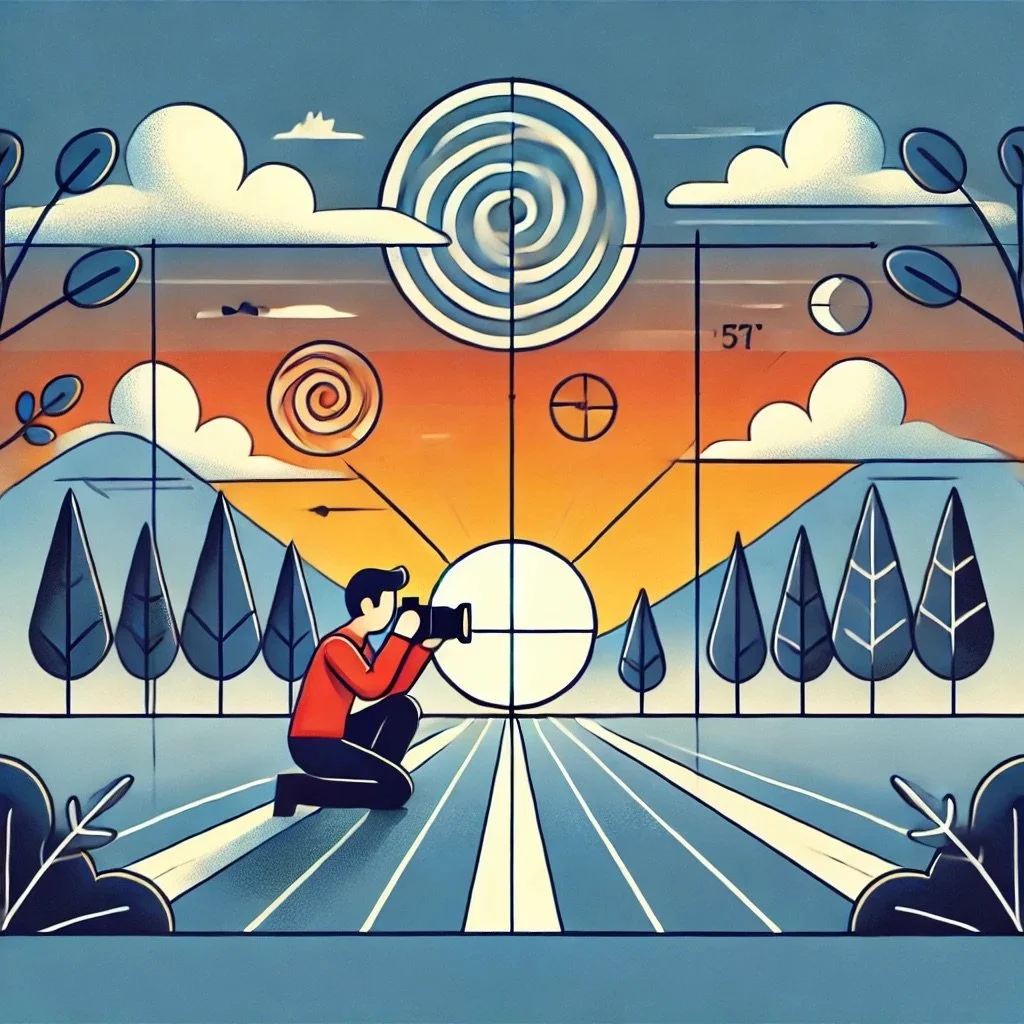Composition is one of the most important elements of photography, yet it’s often overlooked by beginners and even some experienced photographers. In photography, composition refers to the arrangement of elements within a frame, creating a visually compelling and balanced image that captures the viewer’s attention. It’s what makes a photo feel natural, balanced, and engaging, even if the viewer can’t quite put their finger on why.
As famed photographer Edward Weston once said, “Composition is the strongest way of seeing.” It’s not just about what you shoot, but how you arrange the elements in the scene. The way you compose an image can turn a simple subject into a masterpiece. So, what are the essential rules of composition, and how can you use them to elevate your photography?
Let’s dive into the fundamental principles and rules of composition that every photographer should know.
1. The Rule of Thirds
One of the most well-known and widely used composition techniques in photography is the Rule of Thirds. It involves dividing your frame into a grid of nine equal parts by drawing two vertical and two horizontal lines. The idea is to place the most important elements of your photo along these lines or at their intersections, rather than centering your subject.
This technique is so effective because it aligns with how our eyes naturally move across an image. When the subject is placed off-center, it creates a sense of balance and allows the viewer’s eye to explore the entire frame.
How to Use It:
Position your subject where the lines intersect.
For landscapes, place the horizon along the top or bottom third line instead of the middle of the frame.
This rule works well for portraits, landscapes, and street photography.
Pro Tip: You don’t have to follow the Rule of Thirds religiously. It’s a guideline, not a hard rule. Once you’re comfortable with it, try breaking it for more creative compositions.
2. Leading Lines
Leading lines are visual elements that guide the viewer’s eye through the photograph, usually toward the main subject. These lines can be anything—roads, rivers, fences, or even shadows. The goal is to draw attention to the focal point of the image while creating a sense of depth.
How to Use It:
Look for natural or man-made lines that lead toward your subject.
Roads, pathways, railings, and rivers are common examples of leading lines in landscape photography.
Leading lines can start at the bottom of the frame and move toward the subject, pulling the viewer’s eyes into the scene.
Pro Tip: Leading lines don’t have to be straight. Curved or diagonal lines can create a more dynamic and interesting composition.
3. Symmetry and Patterns
Symmetry and patterns can create stunning compositions that are pleasing to the eye. Symmetrical images, where one half of the frame mirrors the other, evoke a sense of balance and harmony. Patterns, whether natural or man-made, can add visual interest and make an image feel more organized and structured.
How to Use It:
Look for reflections in water, glass, or other surfaces to create symmetry.
Use patterns found in architecture, nature, or repeated elements to add structure to your images.
Symmetry works well for architectural and landscape photography, but it can also be effective in portraits and close-up shots.
Pro Tip: Break the symmetry intentionally by introducing an element that disrupts the perfect balance. This contrast can make your image more interesting.
4. Simplification and Exclusion
One of the most effective ways to create a powerful image is to Simplify and Exclude unnecessary elements from the frame. By removing distractions, you can direct the viewer’s attention to the most important parts of the image.
How to Use It:
Identify the main subject of your image and eliminate any elements that don’t support it.
Move closer to your subject, change your angle, or zoom in to focus on the essentials.
The fewer elements in the frame, the stronger the impact of your photo.
Pro Tip: Keep practicing simplification in every shot you take. As you become more experienced, you’ll start to notice distractions in the frame more easily and adjust your composition accordingly.
5. Framing
Framing is a technique where you use elements within the scene to create a natural border around your subject. This can be anything from doorways, windows, trees, or arches that help direct the viewer’s attention to the focal point. Framing adds depth to the image and makes the subject stand out.
How to Use It:
Position your subject within a natural frame like a doorway, window, or arch.
Use elements in the foreground to create a frame around your subject and add depth.
Framing works well for portraits, street photography, and architectural shots.
Pro Tip: Don’t limit yourself to traditional frames. Experiment with less obvious elements like shadows, foliage, or even out-of-focus foreground objects to create unique frames.
6. Balance and Symmetry
Balance in composition refers to distributing visual weight across the image so that no one part feels too heavy or overwhelming. A well-balanced photo feels harmonious, even if the elements aren’t perfectly symmetrical.
There are two types of balance:
Symmetrical Balance: Both sides of the image have similar elements and visual weight.
Asymmetrical Balance: Different elements on each side of the frame are balanced in a way that one side doesn’t overpower the other.
How to Use It:
Pay attention to the visual weight of elements in your image. A large object on one side can be balanced by a smaller object on the other.
Asymmetrical balance can create a more dynamic and visually interesting photo.
Pro Tip: Use color to balance your composition. A bright color in a small area can balance a larger neutral space.
7. Fill the Frame
Sometimes, the best way to create a striking image is to fill the frame with your subject, leaving no empty space around it. This technique eliminates distractions and emphasizes the subject. It works especially well for portraits, macro photography, and abstract shots.
How to Use It:
Move closer to your subject or zoom in until it completely fills the frame.
Make sure there’s no unnecessary background space that takes away from the subject.
Pro Tip: Filling the frame can also create a sense of intimacy, especially in portrait photography, where the viewer feels closer to the subject.
8. Depth of Field and Layering
Creating a sense of depth in your image makes it more engaging and lifelike. Depth of field refers to how much of the scene is in focus, and you can use it to separate your subject from the background or include multiple layers of interest in the frame.
How to Use It:
Use a shallow depth of field (a low f-stop) to blur the background and make the subject stand out.
For landscapes, use a deep depth of field (a higher f-stop) to keep everything in focus, from the foreground to the background.
Pro Tip: Layer your composition by including elements in the foreground, middle ground, and background to create depth and dimension.
9. Negative Space
Negative space is the empty space around your subject. It can be just as important as the subject itself, providing breathing room and allowing the main subject to stand out. Negative space simplifies the composition and adds a sense of minimalism.
How to Use It:
Intentionally leave space around your subject to emphasize it.
Use negative space to create a calm, uncluttered image.
Negative space can be sky, water, walls, or any other large, empty area.
Pro Tip: Negative space works especially well in minimalist photography, where the subject is isolated and the simplicity of the scene is the point.
10. Golden Ratio and Fibonacci Spiral
The Golden Ratio is a mathematical ratio often found in nature that has been used in art and design for centuries. The Fibonacci Spiral is a visual representation of the Golden Ratio, and it helps create balanced and aesthetically pleasing compositions.
While the Rule of Thirds is a simplified version, the Golden Ratio can lead to more complex, but equally harmonious, compositions.
How to Use It:
Use the Fibonacci Spiral to guide where you place key elements in your frame.
Align the most important parts of the image along the spiral’s curve for a more organic and natural composition.
Pro Tip: Most cameras and editing software allow you to overlay the Fibonacci Spiral on your image to help with composition.
Breaking the Rules
As with any set of guidelines, the rules of composition are meant to be broken—once you’ve mastered them. The best photographers understand these principles deeply but are also comfortable bending or breaking the rules when the scene calls for it. Sometimes, a centered subject or a chaotic, asymmetrical composition can create a more powerful or unexpected image.
Conclusion: Composition is the Key to Great Photography
Composition is the foundation of great photography. Whether you’re following the Rule of Thirds, using leading lines, or experimenting with symmetry, these techniques will help you create images that are more visually compelling and memorable. As you practice and become more familiar with these rules, you’ll start applying them instinctively—and, eventually, breaking them to create truly unique compositions.
In the end, composition is all about telling a story with your images, guiding the viewer’s eye, and creating a sense of balance and harmony. By mastering these rules, you’ll be well on your way to capturing photos that stand out and make a lasting impact.

